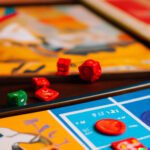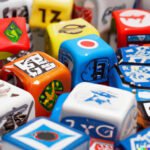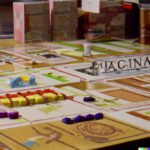Introduction to Board Games
The history of board games goes back at least 5,000 years. Popular board games have been found depicted in Ancient Egyptian tombs, and some believe that certain types of gameboards were used even earlier in Ancient Mesopotamia. Some of the most well-known and widely-played board games created throughout history include senet, feature Asia’s Go and China’s liubo, India’s chaturanga, the western world’s Chess and Risk, as well as modern favorites like Monopoly and Scrabble.
Since ancient times, board games have played an important role not only as a source of entertainment but also in teaching players strategy and critical thinking skills. Examples include Chess which teaches planning tactics while Mancala is designed to help young people learn basic arithmetic skills. In fact, many educational institutions today incorporate board games into their classroom settings to inspire intellectual engagement among students. On a larger scale, all types of traditional behaviors like trade relationships have been modeled by various game designs throughout history.
Board games are typically developed through collaborations between game designers, illustrators or artists for the development of graphics or pieces to be included within the game itself. Game pieces may range from cards and rolled dice to miniature figurines. Storytelling holds an equally important role when creating a game mechanism as does the type of situation defined by such elements like competition versus cooperation regarding whether to help another player reach their goals or sabotage their progress with the ultimate goal of emerging victorious yourself.
Today board games remain incredibly popular across almost every culture around the world; from tactile wooden tiles from East Africa’s Congklak to Mexico’s printable Loterías. This incredible popularity can be attributed both to physical engagements requiring no electricity or digital devices as well as digital variants allowing players around the world to connect over mobile applications or on social networks accessible via computers internet browsers – all leading to unprecedented levels of worldwide collaboration in strategic thinking
Different Types of Board Games and What Genres Work Best
Creating a board game is a detailed process that requires an understanding of the game genre, artwork, components and mechanics. The first step is to brainstorm around themes or ideas that would make a fun game and focus on defining the core mechanics and objectives of the game. This could involve researching different types of board games to determine what already exists in the marketplace. After deciding on a theme or idea, players must then select a game genre. Common genres include strategy games, trivia, roll-and-move, cooperative play and card/deck building. Once the game genre has been selected, players can design the specific rules and components needed. This could include customizing features such as dice or character pieces and designing narrative cards to give players decisions each turn. Artwork should also be designed if necessary and can be done in tandem with rule creation.
The next step involves playtesting the board game with friends or family in order to test for problem areas before retail release. During this stage it is useful for creators to solicit feedback from potential buyers as well as use online marketing tactics like crowdfunding campaigns in order to get feedback from potential customers before full production is underway. Once complete, all materials are finalized before manufacturing them into components for sale or distribution as part of a final product package. Board games come in all shapes and sizes depending on how intricate they may be but they all go through this basic process prior to becoming commercially available.
Design Concepts
Design concepts for board game creation begin with brainstorming ideas, fleshing them out with goals or objectives, and then developing a design concept that is original, creative, and feasible. This requires creative problem solving to come up with a unique theme and structure that both support the core objective of the game while challenging players. From there, designers create a story or narrative to be explored in the game along with characters and setting. Additionally, they decide how interactions between pieces will take place on the board and develop rules and mechanics reflecting those interactions. Detailed depictions of each component should ideally be compiled – whether through hand-sketching or computer-aided design (CAD) software – to get an accurate picture of what is planned before any physical manufacturing begins. After design specifications have been agreed upon by all involved parties, it’s time for production of components and further testing during prototype refining phases. Mock playthroughs should clarify all possible outcomes from different strategies developed by players to refine the game experience until its deemed sufficiently finalized to present to consumers.
Art and Graphics Considerations
When it comes to creating board games, art and graphics are an incredibly important part of the process. Board game developers must consider things like game design, theming, colour schemes and character designs in order to create a visually appealing set of pieces that will draw people in. Many aspects of the game should also be consistent throughout including fonts, shading and character dress. This helps players to easily recognize which pieces belong together and can help them navigate the complex rules of a board game. Developers also need to take into account production cost when designing visual elements; some features may look nice but if they prove too costly to create then they may not be feasible for the budget. Additionally, artwork or details that aren’t required should either be simplified or eliminated altogether so as not to overwhelm newer players who need enough free space on the board in order to learn how pieces move around during play.
Combining Rules and Mechanics to Create an Engaging Board Game
Creating a board game is an involved process. It begins with the concept, which is the general idea of what players are trying to achieve and how they will go about it. Once the idea is established, gameplay mechanics must be determined. This includes determining player goals, establishing game turn orders, and deciding on action options for each player.
Next, rules have to be created. This involves developing specific criteria for victory conditions, as well as setting boundaries for behavior that can affect game strategies such as bidding limits, trading opportunities, and special cards or pieces used during play. The specifics of these rules should be presented in an easy-to-understand format so that both novice and experienced players can enjoy the game without future disagreements about the game’s mechanics or goals.
In addition to building out the basic structure of a board game, it’s important to include aspects that represent its style and theme during development. For example, if a game focuses on pirates then there should be elements of a pirate theme included in every aspect of the design ” from artwork to naming conventions. Finally, components such as boards, dice, pawns and tokens must all come together in order to create a fun interactive experience for players.
When designing a board game it’s important for developers to take into account playtesting feedback throughout every phase of development. This helps them to garner insights into why certain parts of their games may or may not work with their target audience before offering a finished product in stores or online shops. Playtesting also allows developers to adjust any complex rules or mechanics before release so they don’t prevent long-term success or detract from player enjoyment by creating confusion or frustration among gamers.
Creating and Testing Gameplay Prototypes
Creating and testing gameplay prototypes is a crucial step in the process of creating board games. At this stage, the game designer will take their initial design and develop it into more concrete rules. This is often done through playtesting with friends and family, allowing the designer to fine-tune the rules as necessary. Through these playtests, the designer may introduce new elements or mechanics and adjust existing ones – ultimately aiming for a fun gaming experience. The designer should also consider logistics such as modifications needed to run a board game across different environments, scenarios that could arise during gameplay and how players can interact with their components in various ways too. Once complete, the resultant prototype will be ready for further tweaking or to be sent off to potential publishers so they can begin considering a release.
Gaining Insightful Feedback from Players
The process of creating board games involves gaining insightful feedback from players. This typically happens in the early stages of development, when the game has been designed but not yet released for public play-testing. During this phase, designers gather feedback from experienced gamers and industry professionals. Questions are posed to gain insights into components of the game such as ruleset design, artwork, theme, mechanics and overall player experience. The goal is to identify any issues that could affect how enjoyable the game play will be. Additionally, focus groups can be used to receive feedback from non-expert players on topics such as how easy-to-understand the game is and what improvements need to be made before release. Implementing suggestions may involve making small changes or entirely rebuilding aspects of a game in order to create a quality product that people love to play. Through thorough testing and continual improvement of the game prior to launch, companies look to make sure they have created an enjoyable gaming experience that consumers will want to buy for years to come.
Refining and Improving the Design
Once the core concept and rules of the board game have been established, the next step is refining and improving the design. This starts with playtesting, which involves having a group of testers try out different variations of the game to see what works best. Playtesting helps reveal weaknesses or confusing elements that need to be addressed or improved upon in order to make the game as fun and engaging as possible. After playtesting has been done, designers can go back to the drawing board and make any necessary adjustments until they have created a streamlined version. Once the design is finalized, components such as dice and game pieces will be crafted so that it can be ready for production. The design team may also set milestones in developing artwork for cards and boards before going through an extensive prototyping phase for review by publishers who could possibly pick up the game for sale. Finally, once publisher approval is granted, manufacturing will begin on a large-scale so that people all around the world can enjoy these imaginative designs
Taking the Board Game to Market
Once a board game design is finalized and its production costs have been calculated, typically through a factory or manufacturer, it is time to bring the game to market. This involves several steps, from securing the necessary licenses, to conducting focus groups and consumer testing, to arranging marketing campaigns on social media or conventional outlets. Before bringing the game to market, product developers may also work with specific retail outlets or online stores to create special editions of the game that are only available to their customers.
The next step in taking a board game to market is securing manufacturing partners and suppliers who can produce the components of the game. This includes selecting plastic chips, cards, dice, boards, trinkets and other items that are used in the game. Manufacturers must be chosen carefully based on their ability to meet price points and delivery deadlines. In some cases contracts may need to be drawn up between these vendors and the publisher of the board game.
Once manufacturing has been completed it’s time for product testing of both components and gameplay in order that defects can be discovered before hitting the marketplace. This step is essential so any quality control issues do not damage reputation once your game hits the shelves. These tests should include blind playtesting as well as durability and safety testing if necessary.
Finally once everything is ready for launch it’s time for marketing campaigns targeting potential buyers around launch date using traditional media like tv adverts or poster campaigns as well as more recent channels such as email newsletters social media platforms and influencer collaborations for example Youtube personalities who love games! It’s also important at this stage for publishers or retailers to draw up licensing deals with distributors in different parts of their target territories whether online itself or physical bricks-and-mortar stores that could benefit from stocking this particular product
Conclusion
The process of creating a successful board game product is complete when all subtasks are completed. At this point, game designers should be ready to launch the game. This includes assembling any pieces needed, such as spinner or pawns, printing out and organizing detailed rules, conducting market research, taking time to playtest the game with others, and making any necessary adjustments. After the product lands on store shelves, the design team can evaluate its success by tracking sales and customer feedback. Through careful planning and dedication during product development, designers can create a popular board game which will bring enjoyment to generations of players.

I love playing all kinds of games – from classics like Monopoly to modern favourites like Ticket to Ride.
I created this blog as a way to share my love of board games with others, and provide information on the latest releases and news in the industry.





